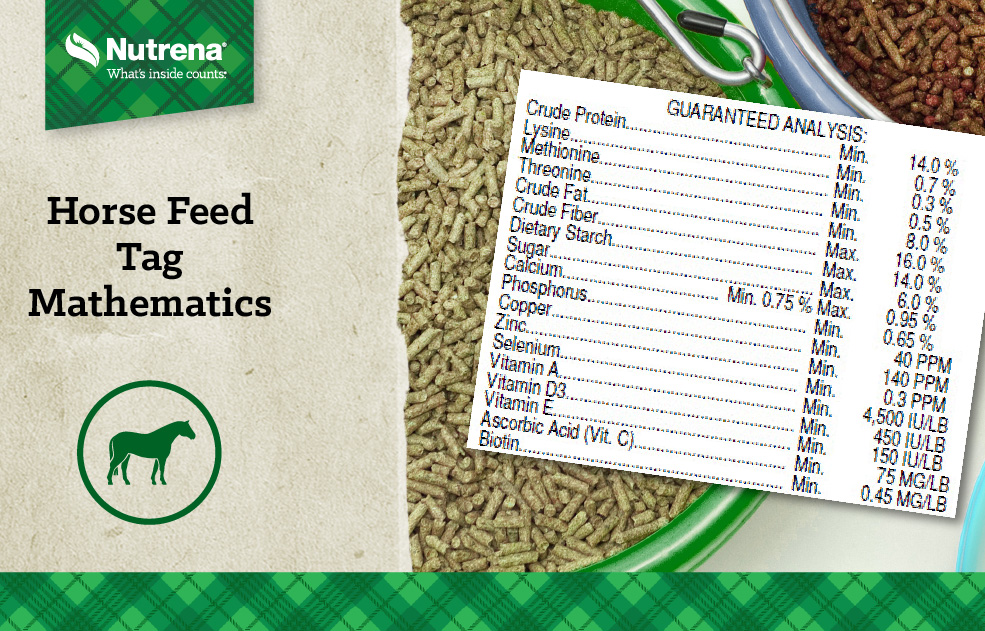Horse Feed Calculator: Feed Tag Math

Horse owners often question what the various units of measure on horse feed tags mean, how to use those units to determine what their horse is consuming, and why they have to be so confusing!
In short, feed companies use the units of nutrient measurements that they are required to use. Horse feeds and other livestock feeds are labeled as required by the American Association of Feed Control Officials (AAFCO) and various state feed control regulations. These regulatory bodies establish the units to be used for each nutrient in tag guarantees.
The following is a list of the four most common units used on feed tags and an overview of how they work.
- Protein, amino acids, fat, fiber and macro minerals (calcium, phosphorus, magnesium and potassium) are listed as a percent minimum or maximum.To calculate the amount supplied per pound, convert percent to a decimal fraction by moving the decimal point two places to the left, then multiply by the pounds fed.
If a horse’s daily intake requirements are given in grams, the pounds of intake can be converted to grams as well.
A Google search of “pounds to grams” can provide a handy conversion calculator if needed.
Example:
A feed that is 14% protein would contain 1 lb x 0.14 = 0.14 lb of protein in 1 lb of feed.Ounces: there are 16 ounces per pound, so the same pound of feed would contain 0.14 x 16 = 2.24 ounces of protein.
Grams: there are 453.6 grams per pound, so the feed would contain 453.6 x 0.14 = 63.5 grams of protein per pound of feed.
Feeding 5 lbs of this feed per day, results in feeding 0.7 lbs, or 11.2 ounces, or 317.5 grams, of protein per day.
- Trace minerals (copper, zinc, manganese and selenium) are expressed as “ppm” or parts per million.One part per million is the same as one milligram per kilogram.
1 kilogram = 2.2 pounds.
Example:
Premium horse feeds are commonly tagged at 0.6 ppm selenium.This is 0.6 mg/kg of feed. This equals 0.273 mg per pound of feed.
0.6 mg/kg divided by 2.2 kg/lb = 0.273 mg per pound of feed.
Feeding 5 lbs of this feed per day results in feeding 1.365 mg of selenium per day.
- Vitamins A, D and E are expressed in IU/lb.An IU is an International Unit and is based on the effectiveness of a particular vitamin.
Because there are some rather complicated conversions of different vitamin sources to International Units, animal requirements are given in International Units, so no further conversion is needed.
Example:
A feed that lists 100 IU/lb of Vitamin E, fed at 5 lbs per day, provides 500 IUs per day. - Vitamin C (or ascorbic acid) and biotin are normally expressed as mg/lb or milligrams per pound.Usually only tagged on senior horse feeds.
Requirements are in mg of intake per day, so no further conversion is needed.
Example:
A feed that lists 75 mg/lb of Vitamin C, fed at 5 lbs per day, provides 375 mg per day.
Again, the right amount matters… if you don’t feed the manufacturer’s minimum feeding rate, your horse’s diet won’t be balanced, and you won’t see the results.
